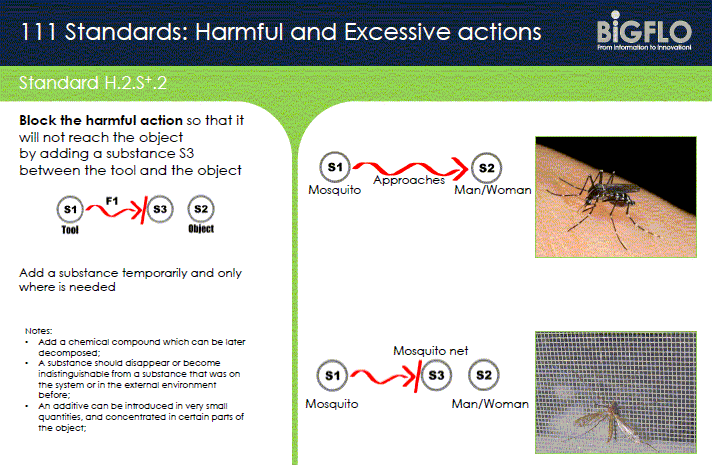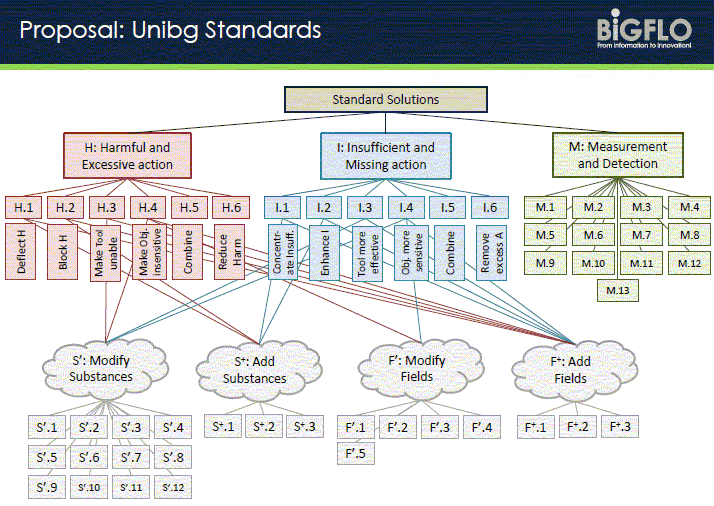Editor's Note and Introduction (Toru Nakagawa, Apr. 28, 2014)
This paper was presented last October at the ETRIA TRIZ Future Conference 2013 in Paris 
 . It is an excellent paper on the TRIZ methodology itself, reorganizing one of the important TRIZ tools in a clear and useful way. Mr. Toshio Takahara willingly translated this paper into Japanese and I brushed it up for posting. In the Japanese page
. It is an excellent paper on the TRIZ methodology itself, reorganizing one of the important TRIZ tools in a clear and useful way. Mr. Toshio Takahara willingly translated this paper into Japanese and I brushed it up for posting. In the Japanese page , the full paper (of 11 pages)
, the full paper (of 11 pages)  and the presentation slides (29 slides)
and the presentation slides (29 slides) are now posted. Here in the English page, however, I am posting this Editor's Note and Introduction only without any links to the English versions at moment. This is because ETRIA is in a negotiation process of openly posting the TFC papers in a publisher's Web site and requesting me to make a link to such postings afterwards. So please wait for some time for the links to original English paper and presentation.
are now posted. Here in the English page, however, I am posting this Editor's Note and Introduction only without any links to the English versions at moment. This is because ETRIA is in a negotiation process of openly posting the TFC papers in a publisher's Web site and requesting me to make a link to such postings afterwards. So please wait for some time for the links to original English paper and presentation.
[If you want to read the paper in English, you might write an email to the authors.
But a better way may be to become a Member of ETRIA (by paying 40 Euro effective for 5 years) having the rights of access to its archives of all the presentations of former TFC conferences.]
The present paper addresses on the Su-Field Model and 76 Inventive Standards both of which were originally developed by G. Altshuller. The authors, Davide Russo and Stefano Duci, reviewed different approaches by many TRIZ researchers after Altshuller, and are proposing a new, reorganized system of Standards. It is based on clear concepts related to functional analysis and is easy to understand and use. Here is my understanding of the authors' new system of Standards:
(1) For expressing the problem situation, the graphical representation with the Su-Field Model is used. However, instead of the particular 'Su-Field Triad' graph by Altshuller, the functional diagram representation, having more commonly accepted bases, is used. The problem situation is to be understood focusing onto its core zone, and is represented by the two objects ('Substances') (i.e., 'Tool' and 'Object') and the interaction (or action, function) between them. Focusing down to the minimum system of two objects and the interaction between them differentiates the TRIZ method from the Functional analysis in general.
(2) Focusing down to the minimum system opens up the possibility of classifying the problem situations and listing up possible solutions. Altshuller intended this with the Su-Field Modeling and the Standards. The present paper tried to reorganize all the information collected in the Altshuller's 76 Standards, while following his original intention. The authors tried to make the new system of Standards easy to understand and use, by structuring the Standards in a uniform and homogeneous way of internal descriptions and in the simple scheme of classification.
(3) First, the problem situations are used for classifying the Standards at the top level of the classification scheme. The problem situation of the interaction between the two substances (or the action/function by the Tool substance onto the Object substance) is the main focus. Problem is either when the action is 'Harmful or Excessive" (hence necessary to reduce its effect) or when the action is 'Insufficient or Missing' (hence necessary to enhance or create its effect). (Other cases of 'Measurement and detection' problem and 'Incomplete minimum system' are less important.)
(4) Then, for each of the two big types of Problem, possible solutions are classified and expressed in simple verbs, called 'Actions'. For the 'Harmful or Excessive' cases, they are 6 verbs, i.e., 'Deflect (the harmful action)', 'Block (the harmful action)', 'Make (the tool) unable', 'Make (the object) insensitive', 'Combine (the system with another system)', and 'Reduce (the harmful action)'. For the 'Insufficient or Missing' cases, 6 verbs are also selected in some logical parallelism with the former ones. The second level of classification thus obtained may be the essence of the present paper.
(5) For each of the 12 'Actions', basic strategies of possible solution are examined and shown as 'Suggestions'. For 'Deflecting the harmful action', for instance, the Action can be achieved by 'Adding a substance between the tool and the object' or by 'Adding a field F2 acting on the field F1'. It was found that only 2 or 3 Suggestions exist at a high abstraction level in this manner for each Action.
(6) The original 76 Standards contain a large amount of information which can make the solution strategies of 'Action-Suggestion' more concrete. Such concretizing and detailing information can be grouped into 4 categories: they are 'Add substances', 'Modify substances', 'Add fields', and 'Modify fields'. The information of these 4 categories are collected in groups, forming 4 'Clouds'. Such Clouds are used/called by a number of different 'Action-Suggestion' strategies. (The scheme of 'calling' Clouds (like subroutines in software programming) eliminates tedious repetition and clarifies the description of the standards.) Some further details of solution means are recorded in the form of notes in the Clouds description, so as to make the new system of Standards homogeneous in the levels of description.
(7) Reorganizing the original Altshuller's Standards by using the concepts and classification scheme explained above, the new System of Standards has been constructed. The University of Bergamo System of 111 Standards has the structure as shown in the following slide:
(8) One of the Standards in the new system is illustrated below, showing its description (left) and its example of well-known application (right). The descriptions in the left column are: 'Action H.2' (the first 2 lines), 'Suggestion S+' (next 2 lines), 'Su-Field Model (in the functional representation)' (the diagram), 'Hint in the S+ Cloud, S+.2' ( next 2 lines), and 'Notes for detailed suggestions' (7 lines). The example in the right column illustrates the Standard in an easy manner.

*** As I explained above, the new system of Standards has a clear overall structure and a simple form of describing individual Standards. The present authors have reviewed well the preceding studies of these TRIZ tools and then reorganized the tools into a new system of Standards. This is an excellent work, I believe. The method pair of 'Su-Field Modeling' and subsequent 'Inventive Standards' was developed by G. Altshuller for 10 years from 1975 to 1985 as one of the principal tools in TRIZ. The method pair has not been widely used in practice for many years. It is now 'modernized' well into a method easy to understand and apply. This is an important contribution to the understanding and development of the TRIZ methodology. I wish to highly appreciate the present authors and the Italian TRIZ group for their contributions. (You can read the recent growth of the TRIZ group in the University of Bergamo in their presentation slides.)
From Altshuller’s 76 Standard Solutions to a new Set of 111 Standards
Davide Russo* and Stefano Duci (University of Bergamo, Italy)
13th ETRIA TRIZ Future Conference (TFC2013), pp. 305-315,
Oct. 29-31, 2013, Ecole Nationale d'Arts et Metiers of Paris, France
Abstract:
The 76 Standard Solutions were created by G. Altshuller as solutions for common inventive problems. Since they were invented, many authors have attempted to improve them, pointing out some difficulties in applying the standards properly and the need to modify this powerful tool. A new system of 111 Standards is proposed, organizing the information of Altshuller’s Standard Solutions according to a simple and rigorous functional approach. Standards are now classified by three Macro-classes which refer to harmful functions, insufficient functions and problem of measurement and detection. Every standard consists of an Action, indicating its functional purpose (such as “blocking” or “deflecting” the harmful action, ”concentrate” or “enhance” the insufficient action, etc.) and a Suggestion, representing how you can realize the goal by adding or modifying fields and substances. A comparison between the old and the new system of standards is proposed.
Keywords: standard solutions, triz, function
Table of Contents of the Paper:
1. Introduction
2. Su-Field Analysis
3. Discussion on Altshuller’s Standard Solutions
3.1. Criticisms and improvement after G. Altshuller
3.2. Information on the Standard solutions
4. Proposal: a new classification for the standard solutions
4.1. The new classes of standards
4.2. A practical example to use the new set of standards
5. Comparison
6. Conclusions
7. References
Paper PDF (11 pages) not linked at moment
Slides PDF (29 slides) not linked at moment
Japanese Page  (HTML)
(HTML)
Nakagawa's Introduction 
Paper in Japanese translation (by Toshio Takahara and Toru Nakagawa) HTML PDF
PDF 
Slides in Japanese translation (by Toshio Takahara and Toru Nakagawa) PDF 

